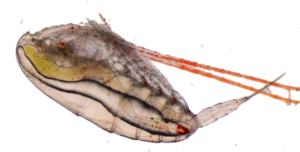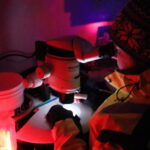CalAct
The impact of light and temperature on Calanus activity patterns in the Arctic

CalAct is an joint project between UiT The Arctic University of Norway and Sentinel North/Université Laval. CalAct is closely collaborating with the NERC funded project CHASE (Chronobiology of changing Arctic Sea Ecosystems) lead by colleagues in the UK and Germany.
The Arctic is characterized by an extreme light climate. Life history events such as reproduction and seasonal migration need to be timed to account for pulsed periods of primary production, and diel activities need to be upheld in periods of continuous light or darkness. Under climate warming, the light regime in the water changes as sea ice extent, thickness, and duration are decreasing. At the same time, zooplankton species experience biogeographical northward shifts following the increased inflow of warmer Atlantic water in the Arctic. This exposes them to stronger seasonal fluctuations in light intensity and photoperiod. The consequences of changes in light climate on Calanus spp. are completely unknown but may trigger behavioural and physiological responses that will alter productivity and disrupt energy flow in Arctic food webs, with implications for northern communities depending on the services provided by the Arctic marine ecosystems.
In CalAct, we use an experimental approach to monitor activity patterns and physiological state of copepods of the genus Calanus, in relation to seasonal and geographical variability in light climate and temperature.
Project ended in 2022

What's happening
In Norway
Cruise with Helmer Hanssen
“We should have been in Canada right now” was probably the most uttered phrase by Estelle and Malin autumn 2020. Alas, what with one thing and another, we could not travel west this year. Instead we took the opportuntity and joined a cruise to Svalbard with RV Helmer Hanssen. On board we conducted activity and respiration measurements of overwintering Calanus finmarchicus sampled along it’s pathway from Northern Norway to northern Svalbard. C. finmarchicus were kept in different temperatures representative of the conditions at overwintering depth. Preliminary analysis show that, not unexpected, activity and respiration increase with temperature. More unexpected, we can also see geographical differences in their activty pattern.
We were able to repeat some of these experiments on a cruise with Helmer Hanssen in January 2022.
In Canada
CCGS Amundsen October 2021
We eventually made it to Canada in October 2021 where we join a cruise within the DarkEdge project in the Northern Baffin Bay. During the four weeks on board we sampled the zooplantkton community, estimate lipid content of the Calansu community and measured activity and respiration rates of Arctci Calanus species.




